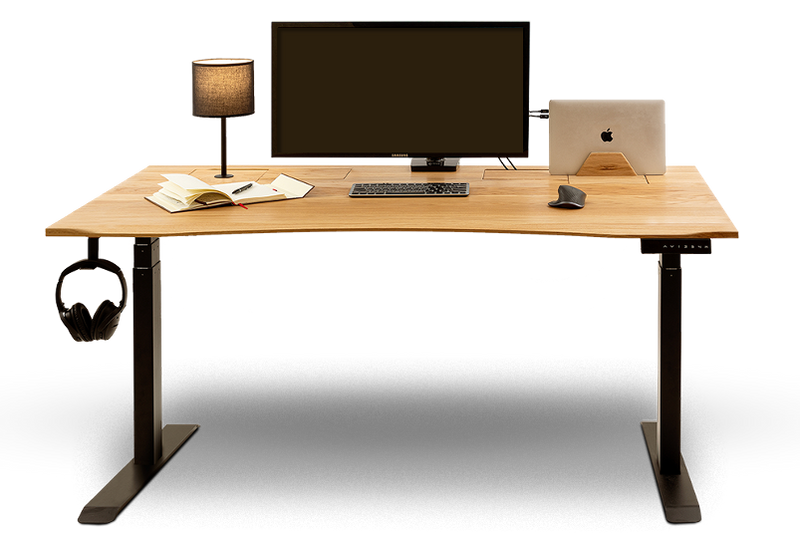Ύψος γραφείου Οδηγός για σωστή ρύθμιση
Λανθασμένο ύψος γραφείου μπορεί να προκαλέσει πόνο ακόμα και μετά την αποχώρηση από το γραφείο. Έχετε ποτέ αισθανθεί πόνο στους ώμους, την πλάτη ή τον αυχένα μετά από ώρες καθιστικής εργασίας στο γραφείο; Σε τέτοιες περιπτώσεις, είναι σημαντικό να ελέγξετε αν το γραφείο σας έχει το σωστό ύψος για εσάς.
Εργονομικά ρυθμιζόμενα γραφεία είναι μια εξαιρετική λύση για την αντιμετώπιση της παρατεταμένης καθιστικής εργασίας. Με τη σωστή ρύθμιση ύψους, θα νιώθετε πιο άνετα και θα είναι ευκολότερο να συγκεντρωθείτε στη δουλειά, τα χόμπι ή τις σπουδές σας. Το ύψος του γραφείου πρέπει να ταιριάζει με το ύψος του σώματός σας και με τα ρυθμιζόμενα γραφεία, η αλλαγή ύψους γίνεται εύκολα.
Θα αλλάξει τον τρόπο που εργάζεστε: Μοναδική λύση διαχείρισης καλωδίων για έναν τακτοποιημένο χώρο και μοναδικά πρόσθετα που θα αντικατοπτρίζουν το προσωπικό σας στυλ. Θα μεταμορφώσει το γραφείο σας σε έναν χώρο έμπνευσης και ομορφιάς: Κάθε γραφείο ErgoHide κατασκευάζεται από πιστοποιημένο και τοπικά προμηθευόμενο στερεό ξύλο δρυός ή καρυδιάς. Κάθε επιφάνεια γραφείου είναι εμποτισμένη με λάδι και ελέγχεται προσωπικά πριν την αποστολή, εξασφαλίζοντας μακροχρόνια ανθεκτικότητα, διαχρονικό στυλ και την φυσική ομορφιά του ξύλου. Θα υποστηρίξει μια τοπική εταιρεία της ΕΕ και την αποστολή μας για αειφορία: Μάθετε περισσότερα στη σελίδα μας About Us, αλλά συνοπτικά – ακολουθούμε μια πρακτική προσέγγιση στην αειφορία. Για κάθε 100 γραφεία που πωλούνται, φυτεύουμε ένα δέντρο για να βοηθήσουμε στην ανανέωση των φυσικών πόρων που χρησιμοποιούμε. Είστε πάντα στην ασφαλή πλευρά μαζί μας: Η εγγύησή μας για επιστροφή χρημάτων 180 ημερών ισχύει ακόμη και για γραφεία ειδικών διαστάσεων και ειδικές αιτήσεις, δίνοντάς σας άφθονο χρόνο για να δοκιμάσετε το γραφείο ErgoHide πριν πάρετε την τελική σας απόφαση. Επιλέξτε την ιδανική σας ρύθμιση και επωφεληθείτε από την ΔΩΡΕΑΝ αποστολή – κάντε κλικ εδώ για να αρχίσετε να ρυθμίζετε το νέο σας γραφείο ErgoHide τώρα!Πετάξτε το παλιό σας, μη εμπνευσμένο και φθαρμένο γραφείο και
ρυθμίστε σήμερα το νέο σας γραφείο ErgoHide.
Θέλετε να ξέρετε γιατί; Γιατί με το ErgoHide μπορείτε:

 Καθαρό ξύλο
Καθαρό ξύλο
 Διαχείριση καλωδίων
Διαχείριση καλωδίων
 Πρόσθετα
Πρόσθετα
 LED εποξικής ρητίνης
LED εποξικής ρητίνης
Τι είναι η εργονομία;
Η εργονομία είναι η επιστήμη που ασχολείται με την επίδραση του εργασιακού εξοπλισμού στον χρήστη και τη ρύθμιση και βελτίωση των χώρων εργασίας για την πρόληψη επαγγελματικών τραυματισμών. Διασφαλίζει ότι οι καρποί, η πλάτη, τα μάτια και άλλα μέρη του σώματος δεν πονούν μετά από ώρες εργασίας. Προλαμβάνει προβλήματα υγείας και βελτιώνει την παραγωγικότητα και την ποιότητα της εργασίας κάνοντας τη δουλειά και τη συγκέντρωση πιο εύκολες.
Σωστό ύψος γραφείου
Δυστυχώς, το λανθασμένο ύψος γραφείου είναι ένα πρόβλημα που επηρεάζει πολλούς υπαλλήλους γραφείου. Λόγω της συνηθισμένης οκτάωρης εργασίας και της ανεπαρκούς κίνησης και διαλειμμάτων, συχνά προκύπτουν προβλήματα στους καρπούς, τα χέρια και τους ώμους.
Πόσο ψηλό πρέπει να είναι το γραφείο σας; Το ύψος του γραφείου εξαρτάται από το ύψος του σώματός σας. Το τυπικό ύψος γραφείου πρέπει να είναι μεταξύ 72 και 75 εκ. Τα περισσότερα γραφεία έχουν ύψος από 70 έως 80 εκ.
Ωστόσο, αυτό το ύψος δεν είναι κατάλληλο για όλους, καθώς τα άτομα με χαμηλότερο ή υψηλότερο ύψος μπορεί να δυσκολεύονται να βρουν ένα γραφείο που να τους υποστηρίζει σωστά. Στην πραγματικότητα, οι περισσότεροι άνθρωποι κάτω των 175 εκ. μπορεί να αντιμετωπίσουν δυσκολίες. Τα γραφεία σταθερού ύψους έχουν σχεδιαστεί ώστε να είναι κατάλληλα για το 90% του πληθυσμού, αλλά ένα σημαντικό ποσοστό των υπαλλήλων μπορεί να διαφωνήσει με αυτή τη δήλωση.
Το σωστό ύψος γραφείου πρέπει να επιτρέπει στα χέρια, τους καρπούς και τις παλάμες σας να βρίσκονται σε ουδέτερη θέση. Ο βασικός κανόνας για τον καθορισμό του ύψους του γραφείου είναι ότι οι αγκώνες σας πρέπει να στηρίζονται ευθεία στο γραφείο και στα μπράτσα της καρέκλας, με γωνία περίπου 90-110 μοίρες. Αυτό είναι το ιδανικό ύψος για να στηρίζετε τα χέρια σας στο γραφείο και ισχύει τόσο για τα καθιστά όσο και για τα όρθια γραφεία. Το ιδανικό ύψος γραφείου θα σας βοηθήσει να διατηρήσετε τη σωστή στάση του σώματος κατά την εργασία. Εάν δεν μπορείτε να χαλαρώσετε τους μυς των ώμων σας και να διατηρήσετε τα χέρια σας σε γωνία 90 μοιρών, το ύψος του γραφείου είναι λανθασμένο.
Ο καθορισμός του σωστού ύψους γραφείου για τις ανάγκες σας είναι ζωτικής σημασίας. Παρακάτω υπάρχει ένας απλός πίνακας ύψους γραφείων για καθιστά και όρθια γραφεία. Χρησιμοποιήστε τον για να προσδιορίσετε το καλύτερο εργονομικό ύψος γραφείου για εσάς, είτε θέλετε να κάθεστε είτε να στέκεστε όρθιοι. Συμπεριλάβετε το ύψος των παπουτσιών σας στη μέτρηση του ύψους του σώματός σας.
|
Ύψος σώματος [cm] |
Ύψος καθιστού γραφείου [cm] |
Ύψος όρθιου γραφείου [cm] |
Ύψος καρέκλας [cm] |
Ύψος οθόνης σε καθιστό γραφείο [cm] |
Ύψος οθόνης σε όρθιο γραφείο [cm] |
|
150 |
54 - 59 |
90 - 97 |
35 - 40.5 |
104 - 107.5 |
139 - 143 |
|
155 |
56.5 - 61.5 |
93 - 100.5 |
36.5 - 41.5 |
107.5 - 111.5 |
143.5 - 147.5 |
|
160 |
59 - 64.5 |
96 - 104 |
38 - 43 |
111 - 115 |
148.5 - 152.5 |
|
165 |
61 - 67.5 |
99 - 107 |
39.5 - 44.5 |
114.5 - 118.5 |
153.5 - 157 |
|
170 |
63.5 - 70 |
102 - 110.5 |
41 - 45.5 |
118.5 - 122.5 |
158 - 161.5 |
|
175 |
66 - 73 |
105 - 114 |
43 - 47 |
122 - 126 |
163 - 166.5 |
|
180 |
68.5 - 75.5 |
108 - 117 |
44.5 - 48.5 |
125.5 - 129.5 |
168 - 171 |
|
185 |
70.5 - 78.5 |
111 - 120.5 |
46 - 50 |
129 - 133.5 |
172.5 - 175.5 |
|
190 |
73 - 81 |
114 - 124 |
47.5 - 51 |
132.5 - 137 |
177.5 - 180.5 |
|
195 |
75.5 - 84 |
117 - 127 |
49.5 - 52.5 |
136.5 - 141 |
182.5 - 185 |
|
200 |
78 - 86.5 |
120 - 130.5 |
51 - 54 |
140 - 144.5 |
187 - 189.5 |
Για τη σωστή ρύθμιση ύψους οθόνης, ο κανόνας είναι να κοιτάτε το πάνω τρίτο της οθόνης όταν κοιτάτε ευθεία μπροστά.
Για το σωστό ύψος καρέκλας, οι μηροί και τα πόδια σας πρέπει να είναι παράλληλα με το πάτωμα, σχηματίζοντας γωνία 90-110 μοιρών μεταξύ των μηρών και των κάτω άκρων.
Ρυθμιζόμενα γραφεία
Ένα ρυθμιζόμενο γραφείο λύνει το πρόβλημα της εύρεσης ενός γραφείου με το κατάλληλο ύψος για εσάς, καθώς ταιριάζει σε όλους. Επειδή τα ρυθμιζόμενα γραφεία μπορούν να προσαρμοστούν σε διάφορα ύψη, μπορούν να προσαρμοστούν σε διαφορετικούς χρήστες. Αυτό τα καθιστά ιδιαίτερα ιδανικά για χώρους και καταστάσεις όπου το ίδιο γραφείο θα χρησιμοποιείται από πολλούς ανθρώπους.
Εκτός από το πλεονέκτημα της ρύθμισης διαφόρων βέλτιστων υψών καθίσματος ανάλογα με το ύψος του χρήστη, τα ρυθμιζόμενα γραφεία έχουν ένα ακόμη σημαντικό όφελος—σας επιτρέπουν να εργάζεστε όρθιοι. Η εναλλαγή μεταξύ καθιστής και όρθιας θέσης είναι πολύ καλύτερη για την υγεία σας από το να κάθεστε ή να στέκεστε όλη μέρα. Η διακοπή των μακρών περιόδων καθιστικής στάσης με ένα ρυθμιζόμενο γραφείο θα βελτιώσει την ευεξία σας, καθώς η αλλαγή της θέσης εργασίας επηρεάζει θετικά τη στάση του σώματος, τη μυϊκή δραστηριότητα, μειώνει την ανάπτυξη πόνου και χρόνιων προβλημάτων και βελτιώνει την άνεση κατά την εργασία.
Άλλοι παράγοντες που επηρεάζουν την επιλογή γραφείου
Το σωστό ύψος γραφείου δεν είναι ο μόνος παράγοντας που πρέπει να λάβετε υπόψη κατά την αγορά ενός νέου γραφείου. Εάν εστιάσετε αποκλειστικά στο ύψος, μπορεί να επιλέξετε λάθος γραφείο για άλλους λόγους. Δώστε προσοχή σε παράγοντες όπως:
- Μέγεθος δωματίου: Βεβαιωθείτε ότι έχετε αρκετό χώρο πριν αγοράσετε ένα γραφείο. Μετρήστε το μήκος και το πλάτος του χώρου που σκοπεύετε να διαθέσετε για το γραφείο και μην ξεχάσετε να υπολογίσετε τον χώρο που θα χρειαστείτε για την καρέκλα. Αφήστε αρκετό χώρο πίσω από την καρέκλα για να γέρνετε πίσω, να περιστρέφεστε και να σηκώνεστε.
- Διαστάσεις γραφείου: Σκεφτείτε τι σκοπεύετε να τοποθετήσετε στο γραφείο. Κάποιοι προτιμούν έναν μινιμαλιστικό σχεδιασμό, ενώ άλλοι χρειάζονται χώρο για έγγραφα, φωτογραφίες, ημερολόγιο, φλιτζάνι, βιβλία, πολλαπλές οθόνες, τηλέφωνο και πολλά άλλα αντικείμενα. Συχνά, είναι καλύτερο να επιλέξετε μια επιφάνεια λίγο μεγαλύτερη από ό,τι νομίζετε ότι θα χρειαστείτε.
Πετάξτε το παλιό σας, μη εμπνευσμένο και φθαρμένο γραφείο και
ρυθμίστε σήμερα το νέο σας γραφείο ErgoHide.
Τα γραφεία ErgoHide διατίθενται σε διάφορα προκαθορισμένα μεγέθη και μπορείτε επίσης να επιλέξετε ένα προσαρμοσμένο μέγεθος που να ταιριάζει στον χώρο σας. Εκτός από τις διαστάσεις του γραφείου, μπορείτε να προσαρμόσετε και άλλα στοιχεία, όπως την επιλογή μεταξύ ανυψωμένης ή παραδοσιακής βάσης, διαφορετικών χρωμάτων, υλικών, σχημάτων γραφείου και αξεσουάρ που θα σας βοηθήσουν στην οργάνωση και τη διαμόρφωση του εργασιακού σας περιβάλλοντος.



















